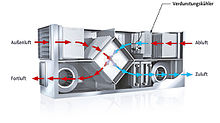Indirect evaporative cooling
The indirect evaporative cooling is a method that the resulting change in the phase evaporative cooling , eg for cooling. B. for cooling the air in a ventilation and air conditioning system (RLT system) uses.
The water evaporation takes place on the exhaust air side of an air conditioning system, whereby warm outside air is cooled by a subsequent heat recovery. The achievable cooling of the outside air is therefore dependent on the amount of evaporated water on the exhaust air side and the design and the efficiency of the heat recovery used. The exhaust air can be humidified to near saturation without an increase in humidity in the supply air. In addition to the air speed with which the evaporative cooler flows, the amount of evaporated water and thus the cooling achieved depends on the air condition with which the exhaust air enters the evaporative cooler. The decisive factors are:
- the air temperature before evaporation: the lower this is, the less moisture can be absorbed and the lower the cooling effect;
- The humidity before evaporation: the more water the air already contains, the less moisture it can absorb and the lower the temperature reduction achieved.
The theoretical limit of evaporative cooling is reached when the air is completely saturated with water - i.e. at a relative humidity of 100%. In air conditioning systems, increases in humidity to values of 92 to 95% are realistic with an economically justifiable effort, depending on the design of the evaporative cooler used.
literature
- Erich Henne: Air humidification . 4th edition. Oldenbourg Publishing House. ISBN 3-486-26289-0 .
- Christian Bremer: Regenerative cold generation by means of indirect evaporative cooling in air conditioning systems . In: Fachjournal 2012 . IHKS Industry Association for Heating, Air Conditioning and Sanitary Technology Bavaria, Saxony and Thuringia eV
